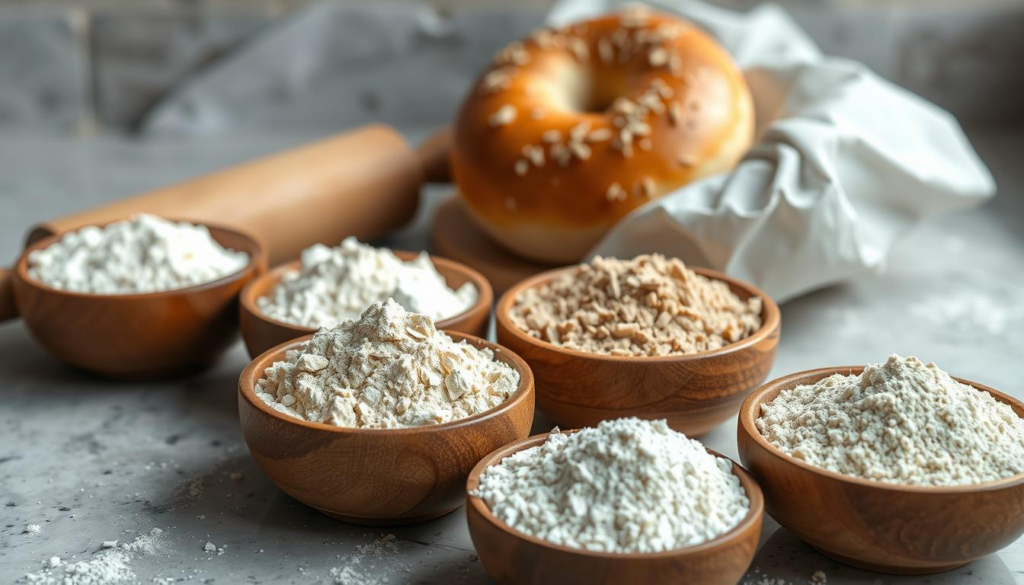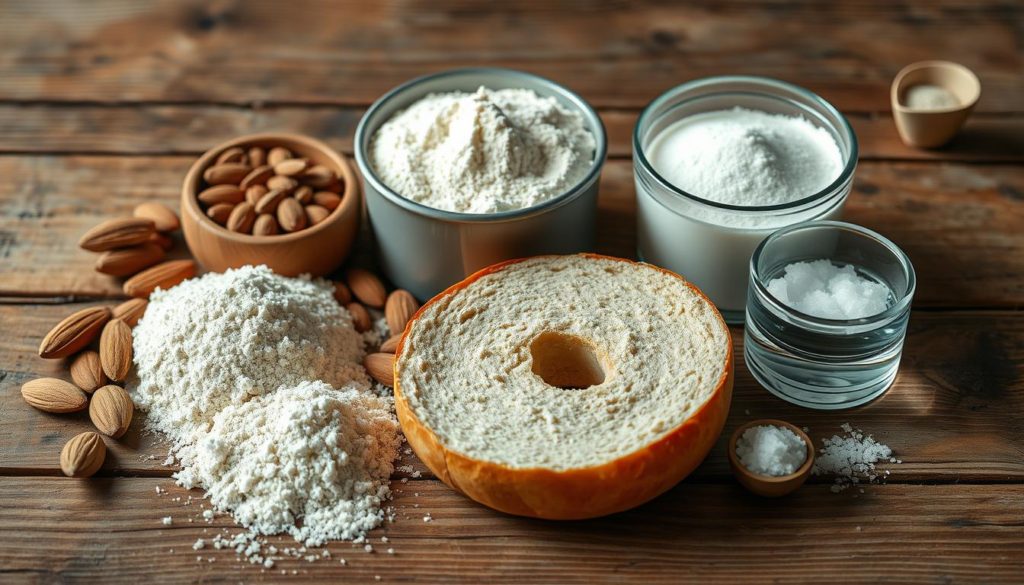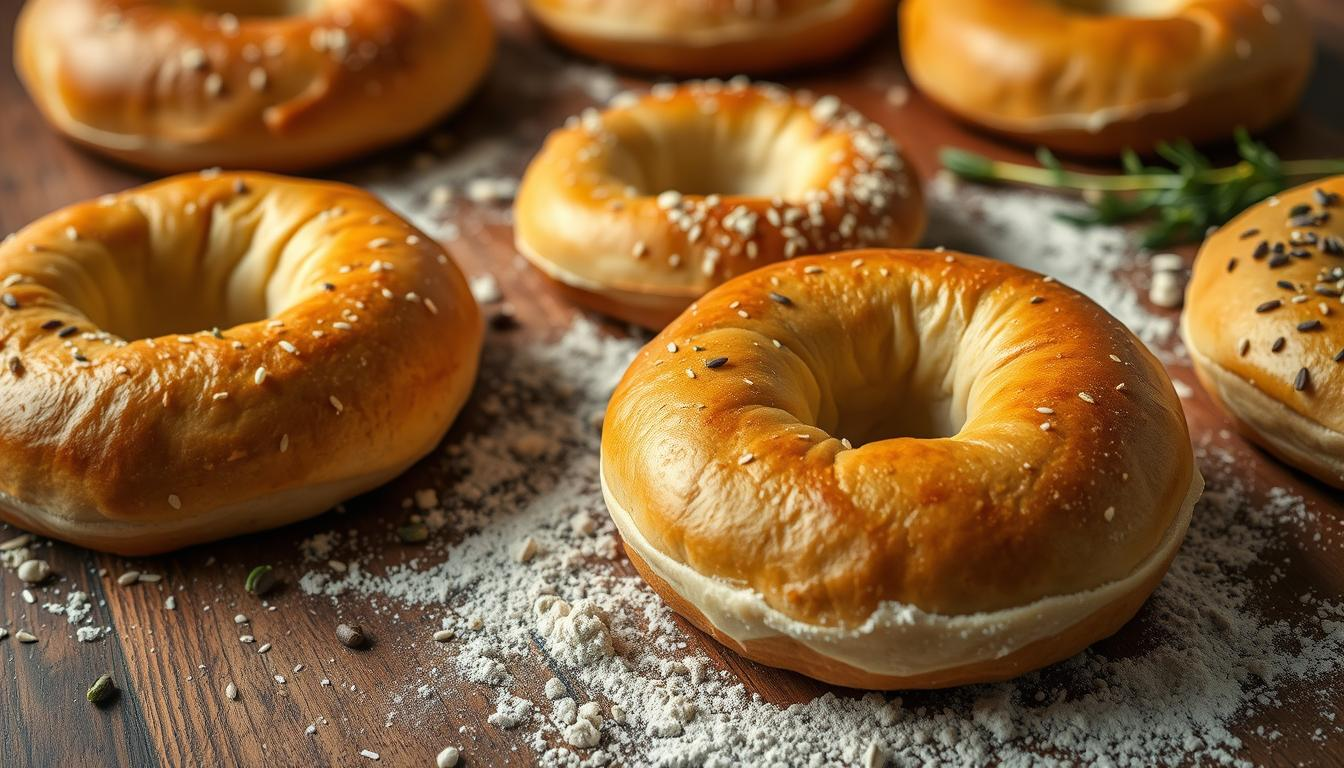Have you ever thought gluten free bagels could taste as good as the ones from the bakery? Imagine biting into a bagel that’s both crisp and chewy. It’s perfect, even with dietary limits.

Table of Contents
Understanding the Basics of Gluten Free Bagels
Exploring gluten-free baked goods is fascinating. It requires knowing how to bake without wheat flour. With the right skills, making healthy bagel alternatives is easy.
Key Ingredients for Gluten-Free Baking
Choosing the right ingredients is key for gluten-free baking. Your kitchen should have:
- Gluten-free flour blends (like rice, almond, or coconut)
- Xanthan gum or psyllium husk (for binding)
- High-protein alternative flours
- Eggs or egg replacements
- Active dry yeast
Essential Equipment Needed
Perfect gluten free bagels need the right tools:
- Large mixing bowl
- Kitchen scale for precise measurements
- Baking sheet with parchment paper
- Stand mixer or hand mixer
- Large pot for boiling
Common Challenges in Gluten-Free Bagel Making
Gluten-free baking has its hurdles. Without wheat flour, texture and density can be hard to achieve. To find the right bagel texture, you must try different flour mixes and binding agents.
Keeping the bagels moist is another big challenge. Gluten-free flours soak up more liquid. So, it’s essential to adjust the liquid amounts to make moist bagels that don’t fall apart.
Best Flour Blends for Authentic Bagel Texture

Starting your gluten-free bagel journey means picking the right flour mix. It’s all about finding the perfect blend for a tasty, allergen-friendly breakfast.
Mix your flours wisely for a real bagel taste. Experts say a unique blend can make gluten-free bagels as good as the real thing.
Ideal Flour Blend Composition
- Rice flour (base ingredient)
- Tapioca starch (for chewiness)
- Potato starch (binding agent)
- Xanthan gum (texture enhancer)
Each part of the mix is key to a great gluten-free bagel. Rice flour gives it shape, and tapioca starch makes it chewy.
Recommended Flour Ratios
| Ingredient | Percentage | Purpose |
|---|---|---|
| Brown Rice Flour | 40% | Primary structure |
| Tapioca Starch | 30% | Chewy texture |
| Potato Starch | 20% | Moisture retention |
| Xanthan Gum | 10% | Binding properties |
Try these ratios to create your ideal gluten-free bagel mix. The right blend will give you a breakfast that’s just as good as the real thing.
Essential Ingredients and Their Purpose
Making tasty gluten-free bagels means knowing the key ingredients. Each one is important for the right texture and taste, and the same is true for vegan and dairy-free bagels.

Binding Agents and Stabilizers
Gluten-free baking needs special care for binding agents. These ingredients replace gluten’s role. Look at these important ones:
- Xanthan gum: Makes dough elastic and keeps it together
- Psyllium husk: Adds binding and improves texture
- Ground flaxseed: Has natural binding properties
Yeast and Leavening Agents
Getting the proper rise in dairy-free bagels is key. Active dry yeast or instant yeast are best for gluten-free. The right leavening agents give volume and a soft inside.
Optional Mix-ins and Toppings
Make your vegan bagels stand out with mix-ins and toppings. Try these:
- Herbs like rosemary or thyme
- Nutritional yeast for a cheesy taste
- Seeds such as sesame, poppy, or everything bagel blend
- Dried fruits or nuts for texture
Choosing the right ingredients lets you make bagels that taste great and suit you. They’re perfect for gluten-free, vegan, or dairy-free diets.
Step-by-Step Mixing and Shaping Process
Making perfect gluten-free bagels requires precision and careful technique. Your gluten-free bagel journey starts with learning the special mixing and shaping steps, which turn simple ingredients into tasty baked goods.
First, could you collect your pre-measured gluten-free flour blend and wet ingredients? The secret to great gluten-free bagels is keeping the proper moisture balance. Also, handle the dough gently.
- Mix dry ingredients well in a big mixing bowl
- Slowly add wet ingredients, stirring until a dough forms
- Let the dough rest for 15-20 minutes to soak up moisture
- Knead the dough softly with wet hands to avoid sticking
Shaping gluten-free bagels is different from traditional recipes. The dough is softer and more delicate. So, it needs gentle handling.
- Split the dough into equal parts
- Shape each part into a smooth ball
- Make a hole in the centre with your thumb or a spoon
- Smooth the edges for a uniform shape
Experts suggest using parchment paper or silicone mats to prevent sticking. This helps your gluten-free bagels keep their shape and texture.
| Technique | Key Considerations |
|---|---|
| Dough Hydration | Crucial for gluten-free bagel structure |
| Gentle Kneading | Keeps delicate ingredients intact |
| Uniform Shaping | Guarantees even baking and look |
Pro tip: Keep your hands slightly damp when handling gluten-free bagel dough. This prevents sticking and gives a smoother finish.
Boiling and Baking Techniques for Perfect Results
Making gluten-free bread needs precision, especially for wheat-free items like bagels. The boiling and baking steps are key to perfect bagel texture and taste.
Water Bath Temperature and Timing
Your gluten-free bagels need careful attention in the water bath stage. Here are the important steps:
- Use water between 200-220°F for the best results
- Boil each bagel for 30-45 seconds on each side
- Make sure the water is gently simmering, not boiling too fast
Optimal Baking Temperature and Duration
Getting the perfect bake means knowing your oven and ingredients well. For gluten-free bread, keeping the temperature right is crucial.
| Oven Setting | Baking Time | Expected Outcome |
|---|---|---|
| 425°F | 18-22 minutes | Golden brown exterior |
| 400°F | 22-25 minutes | Softer, more delicate crust |
Signs of Properly Baked Bagels
Knowing when your wheat-free baked goods are done takes practice. Look for these signs:
- Color: Deep golden-brown surface
- Sound: Hollow sound when tapped on the bottom
- Texture: Crisp outside, soft inside
Mastering these techniques can transform your gluten-free bread into something amazing, ensuring tasty results every time.
Storage Tips and Reheating Methods
Keeping your homemade gluten-free bagels fresh is key. They should taste great and stay soft. Your gluten-free diet doesn’t mean you must give up on delicious bagels.
Storing your bagels right is essential. Here’s how to keep them fresh:
- Room temperature storage: Keep bagels in an airtight container for up to 2 days
- Refrigeration: Store in a sealed bag for 3-4 days maximum
- Freezing: Wrap individually in plastic wrap, then place in a freezer bag
Freezing is the best way to keep your bagels for a long time. When you’re ready to eat them, use these reheating tips:
| Reheating Method | Instructions | Best For |
|---|---|---|
| Toaster | Slice and toast until warm and crispy | Quick single servings |
| Oven | Preheat to 350°F, warm for 5-7 minutes | Restoring original texture |
| Microwave | 15-20 seconds, wrapped in a damp paper towel | Fast reheating |
Pro tip: Always thaw frozen bagels at room temperature before reheating. This prevents moisture loss and keeps them soft. These tips will help you enjoy your gluten-free bagels like they were fresh from the oven.
Related Article: Discover Delicious Gluten-Free Goldfish Crackers
Conclusion
Making gluten-free bagels at home is a fun adventure. It turns your kitchen into a gluten-free bakery. You’ll learn to make tasty bagels without gluten, showing you can still enjoy great baking even with dietary limits.
Every batch of gluten-free bagels is a chance to try new flavours and textures. You can add sesame seeds or bold seasonings. Your skills will let you make bagels just the way you like them.
Your hard work in making gluten-free bagels will open up a world of tasty options. Be patient, trust yourself, and enjoy making healthy and delicious bread.
Gluten-Free Bagels are typically made using gluten-free flour like almond flour, rice flour, or tapioca flour, combined with binders like xanthan gum or psyllium husk to mimic the texture of traditional bagels.
Gluten-free bagels are a great choice for people with gluten intolerance or celiac disease. While they can be a healthy option, the nutritional profile depends on the ingredients used, so always check the label.
You can make Gluten-Free Bagels at home using gluten-free flour, yeast, water, and optional flavourings like seeds or herbs. Please look for recipes designed for gluten-free baking to make sure they are successful.
Gluten-free bagels often have a slightly different texture and taste than regular bagels, but they can still be chewy and delicious, especially when toasted or topped with spreads.
Not all gluten-free labelled bagels are safe for celiac disease. Always look for certifications like “Certified Gluten-Free” to ensure no cross-contamination during production.

